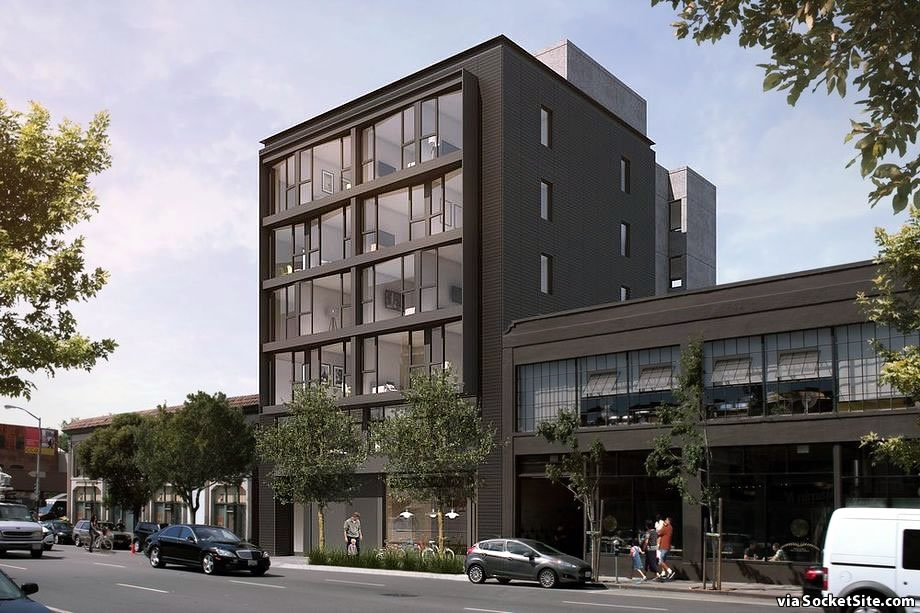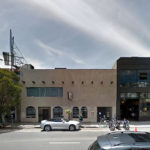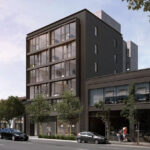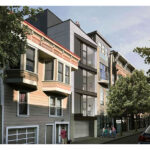Acquired for $4.125 million in June of 2016, plans to level the shuttered nightclub space at 280 7th Street – a through block building which was once home to “Rawhide II,” the only Country Western club in San Francisco – and build 20 condos upon the Western SoMa site were soon drawn, revised and approved by Planning back in 2018.
Demolition and building permits for the six-story development were subsequently requested and approved in August of 2019, but the ground for the development has yet to be broken. And the fully-entitled development/site, which was designed to yield a mix of 12 one-bedrooms, 6 twos, 2 threes and a ground floor retail space, is now back on market with a $3.25 million price tag.





I don’t think projects of this size are penciling-out at all these days.
I suspect the entitlements are worthless. We may see the site change hands and a new project be put forward utilizing state density bonuses to go taller, maybe nine or ten stories. Even with that, I am not sure there will be any rush to put shovels in the ground. In addition to the crazy-high cost of construction, the cost of financing has now increased significantly, making it even tougher to make the numbers work.
I hope my pessimistic words are wrong. But I fear they are correct.
No need to feel pessimistic. This might simply be market forces working for the better. If construction costs are too high then it could encourage innovators who can build at lower cost. If raze and rebuild still does not pencil out then creative adaptive reuse can increase value at lower cost.
Though recent decades brought a building boom, it also created significant unnecessary waste. Growth need not happen all at once. Lets hope that San Francisco has centuries of progress ahead of it.
Been there. What with Local 38 et al swooping in last year, shutting down East Bay-built pre-fab units that could be constructed into residential buildings in town. As of right now, their plumbers sit at home pulling down EDD by the hundreds – I get the sense there’s a stalemate between old school cruft and new thinking, with the former hoping they can coast through the lull within the current power structure.
Keep in mind that the average development under construction in San Francisco measures 18 units, the average entitled pipeline project for which building permits have already been issued measures closer to 15 units, and the average entitled project in San Francisco for which building permits have been approved, but have yet to be issued, measures a little over 22 units.
In other words, “projects of this size [which aren’t] penciling-out at all these days” are representative of the average approved pipeline project in San Francisco as segmented above and it’s not due to NIMBYs or other bogeyman commonly fingered in the press or fundraising efforts.
Yep. So the average pipeline project in San Francisco is not going to get built.
Well the stats above state that the average development already being built is 18 units; so it sounds like some of it will.
“[T]he number of units under construction across the city, units which should be ready for occupancy within the next year or two, actually dropped by 1,300 to 7,800 at the end of last year, representing 9 percent fewer units under construction than there were at the end of 2020 but 10 percent more than average over the past decade with another 9,000 units that have been approved and permitted and another 9,000 entitled units for which building permits have been requested,” as we outlined back in March.
Is data available on the number of projects that have been approved, permitted and entitled and had the entitlement put up for sale?
When you’re City ruins its brand, this is what happens. It took us a decade to recover from the ‘89 quake. But it’s fixed in time. This brand-ruining process is ongoing and unabated.
Huh? Loma Prieta ruined the city’s brand and that’s why we can’t build mid-rise condos in 2022??
I’d wager it has far more to do with inflation, implied shift towards remote work, labor shortages, exaggerated delays, and ultimately a disgustingly convoluted approval process (just to name a few).
Well, you are both right.
SF’s crazy politics have allowed for an army of criminal addicts to pitch tents and roam the streets – ruining the City for most and driving businesses out (the plethora of business taxes don’t help). That’s our brand now. Who wants to deal with that? No one.
Remote work (reduced demand and rents), labor, delays, crazy and unpredictable entitlement process, out of control costs – what developer and capital partner wants to build in this environment? None.
SF is damaged. Only time will tell if the City recovers. After +2 decades of building here, this is the first time I’ve felt it might be permanent.
Benign-neglect acceptance of Fentanyl on the streets and the awful social ramifications that follow are the worst culprits in my book, as far as San Francisco brand-tarnishing goes.
Excessively high construction costs will keep many of these pretty pictures unbuilt, but eventually rents will ascend to make them worth it. It’s usually easier to buy an existing building and fix it up rather than build from scratch. Have any of these projects begun construction?
1. Plans for Building Up in The Castro
2. Plans for 14-Story Variegated Tower Slated for Approval
3. Hayes Valley Infill Building Has Been Officially Approved
And/or land values will drop, as is the allusion above with asking rents in San Francisco still down 16 percent from pre-pandemic levels and 23 percent below a 2015-era peak.
More telling is the abandonment of larger projects. It started before Covid. Kirkham Heights would have been, at 450 units, the largest development ever in the Inner Sunset. The developer backed out in 2017 for economic reasons. I assume the entitlement was put up for sale but, 5 years later, the project appears dead. TMG and Suter have halted development of 3700 California (almost 300 units) and put the 5 acre parcel up for sale. Will they find a buyer? Who knows.
Pier 70 is on hold and, is appraisals keep coming in low, could be on hold for the indefinite period.
Most of the pipeline is made up of medium sized projects. Less than 30 units. Often the developers don’t have the deep pockets that developers of larger projects like the CPMC campus have. Meaning most of the projects, once entitled, will likely be put up for sale. Smaller developers can’t afford to sit on an entitlement for years as the (lost) opportunity cost of money is especially felt by them.
You came nowhere near being able to draw the conclusion you drew based upon the examples you gave. But for once I happen to agree with something you wrote. It is a fact that smaller to mid size developers will unnecessarily pay too much holding costs / opportunity cost in order to entitle projects as they languish in the broken facility that is DBI. Then, because they’ve unnecessarily sat around for an extra year or more, many developers will explore what fighting that good fight is actually worth on the open market. It would be good if every time one of these things are featured there is clear language indicating whether something is fully entitled and shovel ready, or merely nearly approved by Planning, or looking likely to be approved y Planning, etc etc.
Actually, the smaller development market is more telling as smaller projects are typically easier to finance, cheaper to construct and less risky.
“Approved SoMa development”, approved by planning, site permit only approved by building
“Hayes Valley…Approved”, approved by planning, site permit not yet approved
“Building Up in the Castro”, not anywhere near getting out of the planning department let alone through building
“…variegated tower”, just had the shadow study approved in Feb., on to environmental and on and on and on through planning and then someday onto building
So to answer your question, no they haven’t begun building but not because of material costs but because they are very far away from having permits to build.
I’m sure you are correct. I guess my more specific question is whether any 12 unit and under projects have broken ground since March 2020.
All of the designs on standard lots <30’ wide that have elevators are very expensive to build (with two exit stairs) and yield small units.
But maybe I am missing something.